Comprehensive Report on Legal and Professional Issues in Nursing
VerifiedAdded on 2020/05/11
|12
|3345
|243
Report
AI Summary
This report provides a comprehensive analysis of a case involving two Registered Nurses (RNs) and the death of a six-month-old baby, focusing on the legal and professional issues that arose. The analysis examines the RNs' alleged failure to appropriately manage and communicate changes in the patient's condition, as well as their failure to maintain adequate clinical records. The report delves into key terms such as professional conduct in nursing, the nurse's code of ethics, and professional responsibilities. It explores ethical breaches related to the Nursing and Midwifery Board of Australia (NMBA) codes of ethics, including the ethical management of information and the importance of RN standards. The report also discusses the RNs' responsibilities in providing safe, quality nursing care, including comprehensive assessments, planning, implementation, and evaluation of outcomes. Furthermore, the report highlights the importance of accountability, ethical information management, and the roles of colleagues and the community in upholding ethical standards. The breach of professional conduct statements and the ethical violations are analyzed, providing insights into the impact of these failures on patient care and the nursing profession.
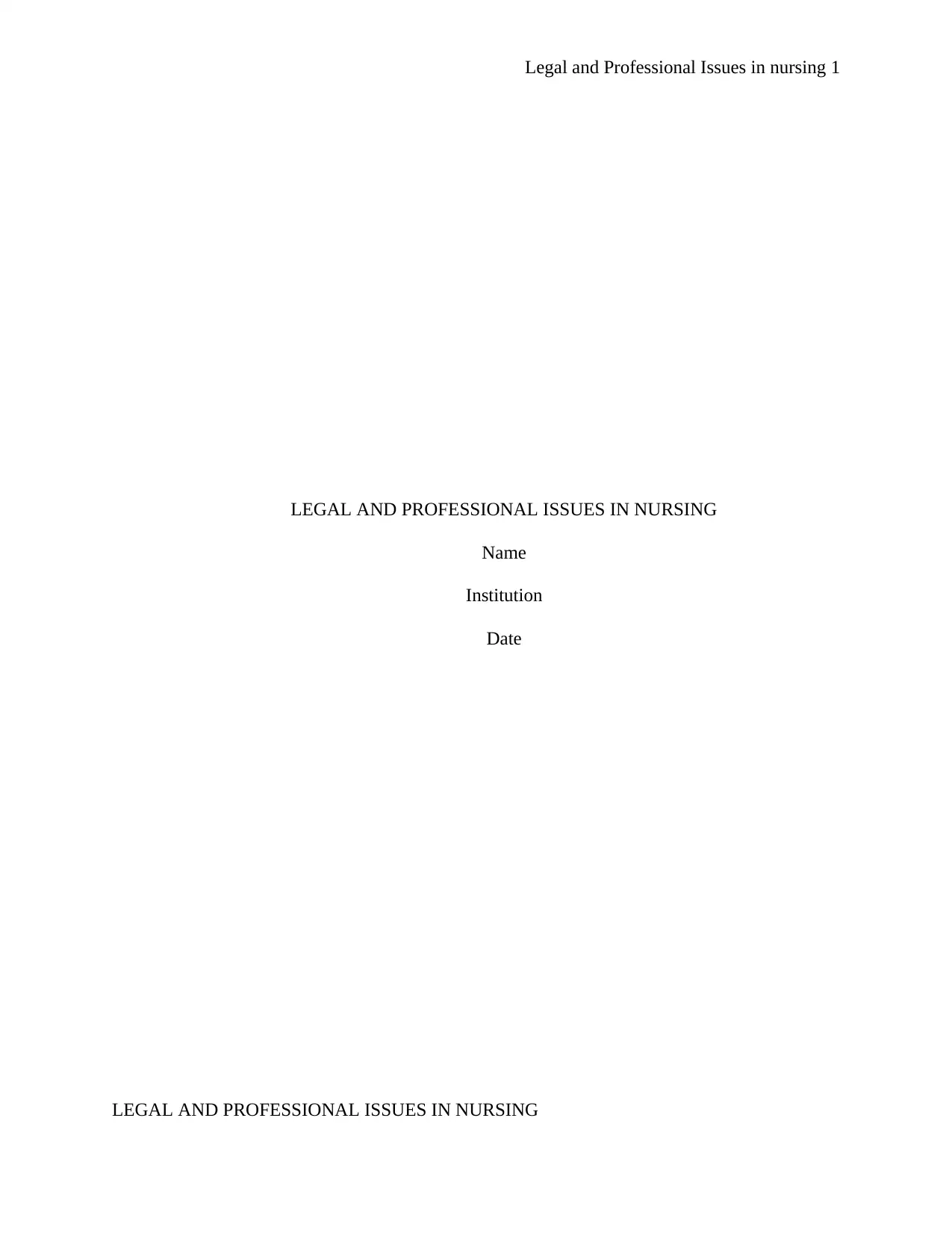
Legal and Professional Issues in nursing 1
LEGAL AND PROFESSIONAL ISSUES IN NURSING
Name
Institution
Date
LEGAL AND PROFESSIONAL ISSUES IN NURSING
LEGAL AND PROFESSIONAL ISSUES IN NURSING
Name
Institution
Date
LEGAL AND PROFESSIONAL ISSUES IN NURSING
Paraphrase This Document
Need a fresh take? Get an instant paraphrase of this document with our AI Paraphraser
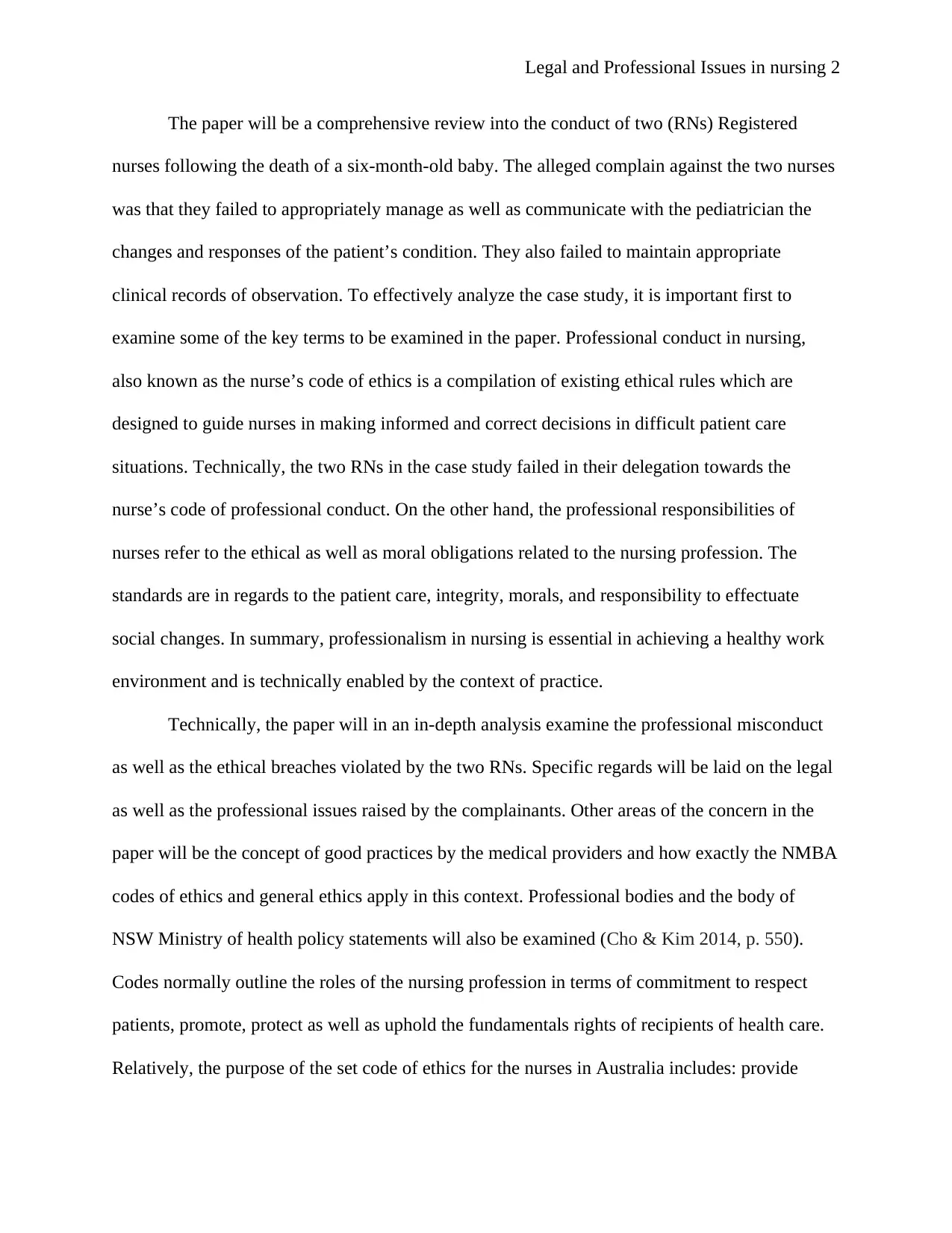
Legal and Professional Issues in nursing 2
The paper will be a comprehensive review into the conduct of two (RNs) Registered
nurses following the death of a six-month-old baby. The alleged complain against the two nurses
was that they failed to appropriately manage as well as communicate with the pediatrician the
changes and responses of the patient’s condition. They also failed to maintain appropriate
clinical records of observation. To effectively analyze the case study, it is important first to
examine some of the key terms to be examined in the paper. Professional conduct in nursing,
also known as the nurse’s code of ethics is a compilation of existing ethical rules which are
designed to guide nurses in making informed and correct decisions in difficult patient care
situations. Technically, the two RNs in the case study failed in their delegation towards the
nurse’s code of professional conduct. On the other hand, the professional responsibilities of
nurses refer to the ethical as well as moral obligations related to the nursing profession. The
standards are in regards to the patient care, integrity, morals, and responsibility to effectuate
social changes. In summary, professionalism in nursing is essential in achieving a healthy work
environment and is technically enabled by the context of practice.
Technically, the paper will in an in-depth analysis examine the professional misconduct
as well as the ethical breaches violated by the two RNs. Specific regards will be laid on the legal
as well as the professional issues raised by the complainants. Other areas of the concern in the
paper will be the concept of good practices by the medical providers and how exactly the NMBA
codes of ethics and general ethics apply in this context. Professional bodies and the body of
NSW Ministry of health policy statements will also be examined (Cho & Kim 2014, p. 550).
Codes normally outline the roles of the nursing profession in terms of commitment to respect
patients, promote, protect as well as uphold the fundamentals rights of recipients of health care.
Relatively, the purpose of the set code of ethics for the nurses in Australia includes: provide
The paper will be a comprehensive review into the conduct of two (RNs) Registered
nurses following the death of a six-month-old baby. The alleged complain against the two nurses
was that they failed to appropriately manage as well as communicate with the pediatrician the
changes and responses of the patient’s condition. They also failed to maintain appropriate
clinical records of observation. To effectively analyze the case study, it is important first to
examine some of the key terms to be examined in the paper. Professional conduct in nursing,
also known as the nurse’s code of ethics is a compilation of existing ethical rules which are
designed to guide nurses in making informed and correct decisions in difficult patient care
situations. Technically, the two RNs in the case study failed in their delegation towards the
nurse’s code of professional conduct. On the other hand, the professional responsibilities of
nurses refer to the ethical as well as moral obligations related to the nursing profession. The
standards are in regards to the patient care, integrity, morals, and responsibility to effectuate
social changes. In summary, professionalism in nursing is essential in achieving a healthy work
environment and is technically enabled by the context of practice.
Technically, the paper will in an in-depth analysis examine the professional misconduct
as well as the ethical breaches violated by the two RNs. Specific regards will be laid on the legal
as well as the professional issues raised by the complainants. Other areas of the concern in the
paper will be the concept of good practices by the medical providers and how exactly the NMBA
codes of ethics and general ethics apply in this context. Professional bodies and the body of
NSW Ministry of health policy statements will also be examined (Cho & Kim 2014, p. 550).
Codes normally outline the roles of the nursing profession in terms of commitment to respect
patients, promote, protect as well as uphold the fundamentals rights of recipients of health care.
Relatively, the purpose of the set code of ethics for the nurses in Australia includes: provide
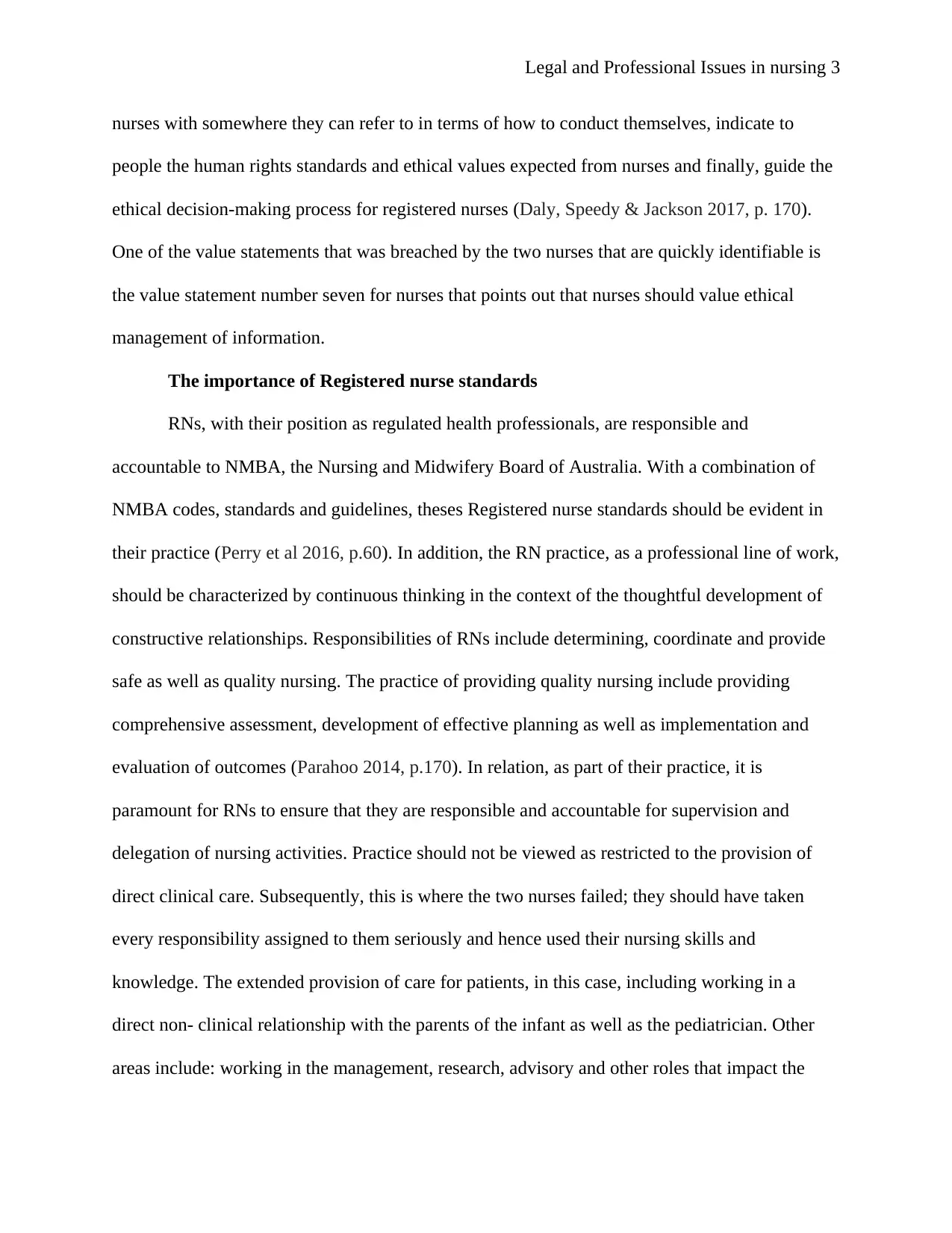
Legal and Professional Issues in nursing 3
nurses with somewhere they can refer to in terms of how to conduct themselves, indicate to
people the human rights standards and ethical values expected from nurses and finally, guide the
ethical decision-making process for registered nurses (Daly, Speedy & Jackson 2017, p. 170).
One of the value statements that was breached by the two nurses that are quickly identifiable is
the value statement number seven for nurses that points out that nurses should value ethical
management of information.
The importance of Registered nurse standards
RNs, with their position as regulated health professionals, are responsible and
accountable to NMBA, the Nursing and Midwifery Board of Australia. With a combination of
NMBA codes, standards and guidelines, theses Registered nurse standards should be evident in
their practice (Perry et al 2016, p.60). In addition, the RN practice, as a professional line of work,
should be characterized by continuous thinking in the context of the thoughtful development of
constructive relationships. Responsibilities of RNs include determining, coordinate and provide
safe as well as quality nursing. The practice of providing quality nursing include providing
comprehensive assessment, development of effective planning as well as implementation and
evaluation of outcomes (Parahoo 2014, p.170). In relation, as part of their practice, it is
paramount for RNs to ensure that they are responsible and accountable for supervision and
delegation of nursing activities. Practice should not be viewed as restricted to the provision of
direct clinical care. Subsequently, this is where the two nurses failed; they should have taken
every responsibility assigned to them seriously and hence used their nursing skills and
knowledge. The extended provision of care for patients, in this case, including working in a
direct non- clinical relationship with the parents of the infant as well as the pediatrician. Other
areas include: working in the management, research, advisory and other roles that impact the
nurses with somewhere they can refer to in terms of how to conduct themselves, indicate to
people the human rights standards and ethical values expected from nurses and finally, guide the
ethical decision-making process for registered nurses (Daly, Speedy & Jackson 2017, p. 170).
One of the value statements that was breached by the two nurses that are quickly identifiable is
the value statement number seven for nurses that points out that nurses should value ethical
management of information.
The importance of Registered nurse standards
RNs, with their position as regulated health professionals, are responsible and
accountable to NMBA, the Nursing and Midwifery Board of Australia. With a combination of
NMBA codes, standards and guidelines, theses Registered nurse standards should be evident in
their practice (Perry et al 2016, p.60). In addition, the RN practice, as a professional line of work,
should be characterized by continuous thinking in the context of the thoughtful development of
constructive relationships. Responsibilities of RNs include determining, coordinate and provide
safe as well as quality nursing. The practice of providing quality nursing include providing
comprehensive assessment, development of effective planning as well as implementation and
evaluation of outcomes (Parahoo 2014, p.170). In relation, as part of their practice, it is
paramount for RNs to ensure that they are responsible and accountable for supervision and
delegation of nursing activities. Practice should not be viewed as restricted to the provision of
direct clinical care. Subsequently, this is where the two nurses failed; they should have taken
every responsibility assigned to them seriously and hence used their nursing skills and
knowledge. The extended provision of care for patients, in this case, including working in a
direct non- clinical relationship with the parents of the infant as well as the pediatrician. Other
areas include: working in the management, research, advisory and other roles that impact the
⊘ This is a preview!⊘
Do you want full access?
Subscribe today to unlock all pages.

Trusted by 1+ million students worldwide
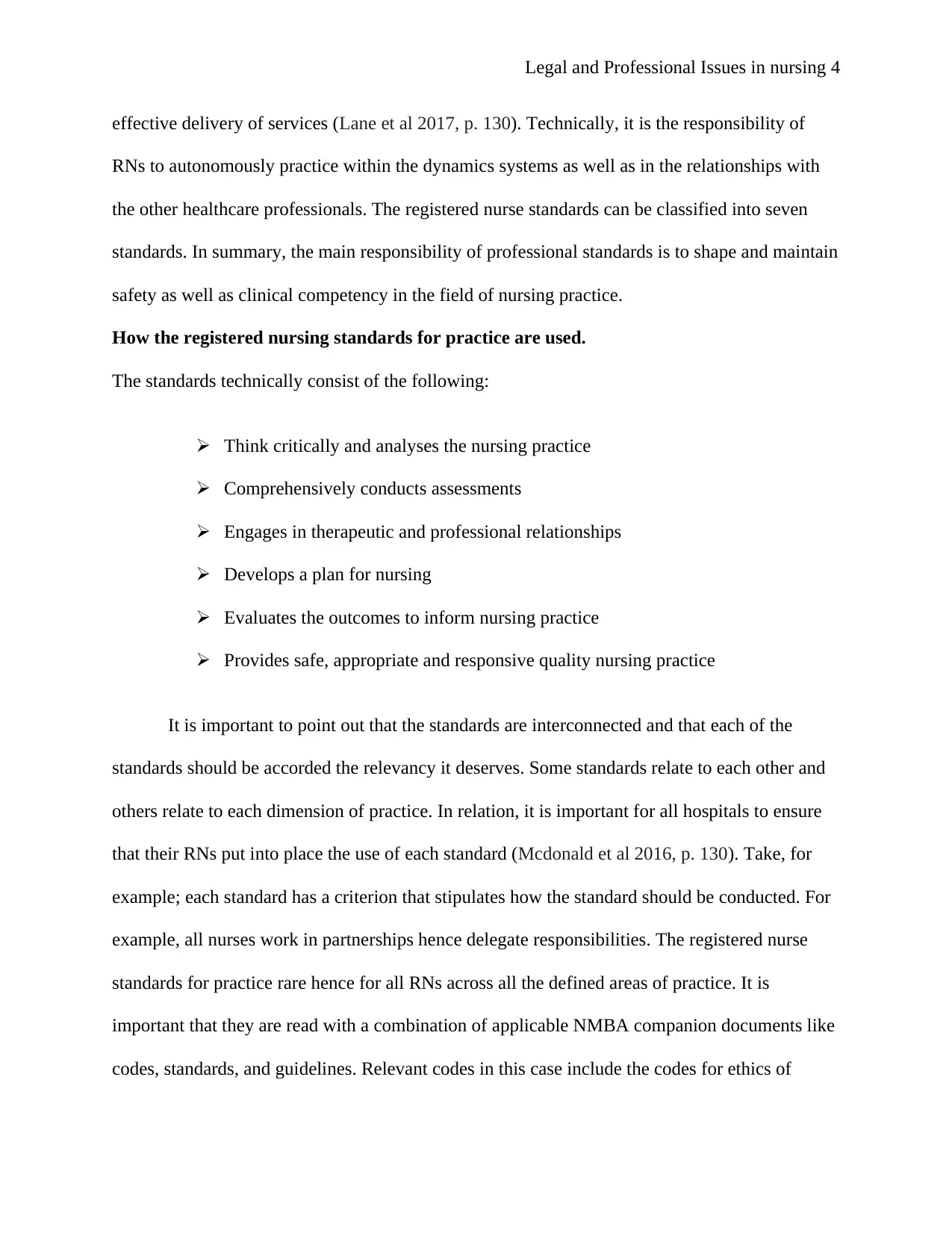
Legal and Professional Issues in nursing 4
effective delivery of services (Lane et al 2017, p. 130). Technically, it is the responsibility of
RNs to autonomously practice within the dynamics systems as well as in the relationships with
the other healthcare professionals. The registered nurse standards can be classified into seven
standards. In summary, the main responsibility of professional standards is to shape and maintain
safety as well as clinical competency in the field of nursing practice.
How the registered nursing standards for practice are used.
The standards technically consist of the following:
Think critically and analyses the nursing practice
Comprehensively conducts assessments
Engages in therapeutic and professional relationships
Develops a plan for nursing
Evaluates the outcomes to inform nursing practice
Provides safe, appropriate and responsive quality nursing practice
It is important to point out that the standards are interconnected and that each of the
standards should be accorded the relevancy it deserves. Some standards relate to each other and
others relate to each dimension of practice. In relation, it is important for all hospitals to ensure
that their RNs put into place the use of each standard (Mcdonald et al 2016, p. 130). Take, for
example; each standard has a criterion that stipulates how the standard should be conducted. For
example, all nurses work in partnerships hence delegate responsibilities. The registered nurse
standards for practice rare hence for all RNs across all the defined areas of practice. It is
important that they are read with a combination of applicable NMBA companion documents like
codes, standards, and guidelines. Relevant codes in this case include the codes for ethics of
effective delivery of services (Lane et al 2017, p. 130). Technically, it is the responsibility of
RNs to autonomously practice within the dynamics systems as well as in the relationships with
the other healthcare professionals. The registered nurse standards can be classified into seven
standards. In summary, the main responsibility of professional standards is to shape and maintain
safety as well as clinical competency in the field of nursing practice.
How the registered nursing standards for practice are used.
The standards technically consist of the following:
Think critically and analyses the nursing practice
Comprehensively conducts assessments
Engages in therapeutic and professional relationships
Develops a plan for nursing
Evaluates the outcomes to inform nursing practice
Provides safe, appropriate and responsive quality nursing practice
It is important to point out that the standards are interconnected and that each of the
standards should be accorded the relevancy it deserves. Some standards relate to each other and
others relate to each dimension of practice. In relation, it is important for all hospitals to ensure
that their RNs put into place the use of each standard (Mcdonald et al 2016, p. 130). Take, for
example; each standard has a criterion that stipulates how the standard should be conducted. For
example, all nurses work in partnerships hence delegate responsibilities. The registered nurse
standards for practice rare hence for all RNs across all the defined areas of practice. It is
important that they are read with a combination of applicable NMBA companion documents like
codes, standards, and guidelines. Relevant codes in this case include the codes for ethics of
Paraphrase This Document
Need a fresh take? Get an instant paraphrase of this document with our AI Paraphraser
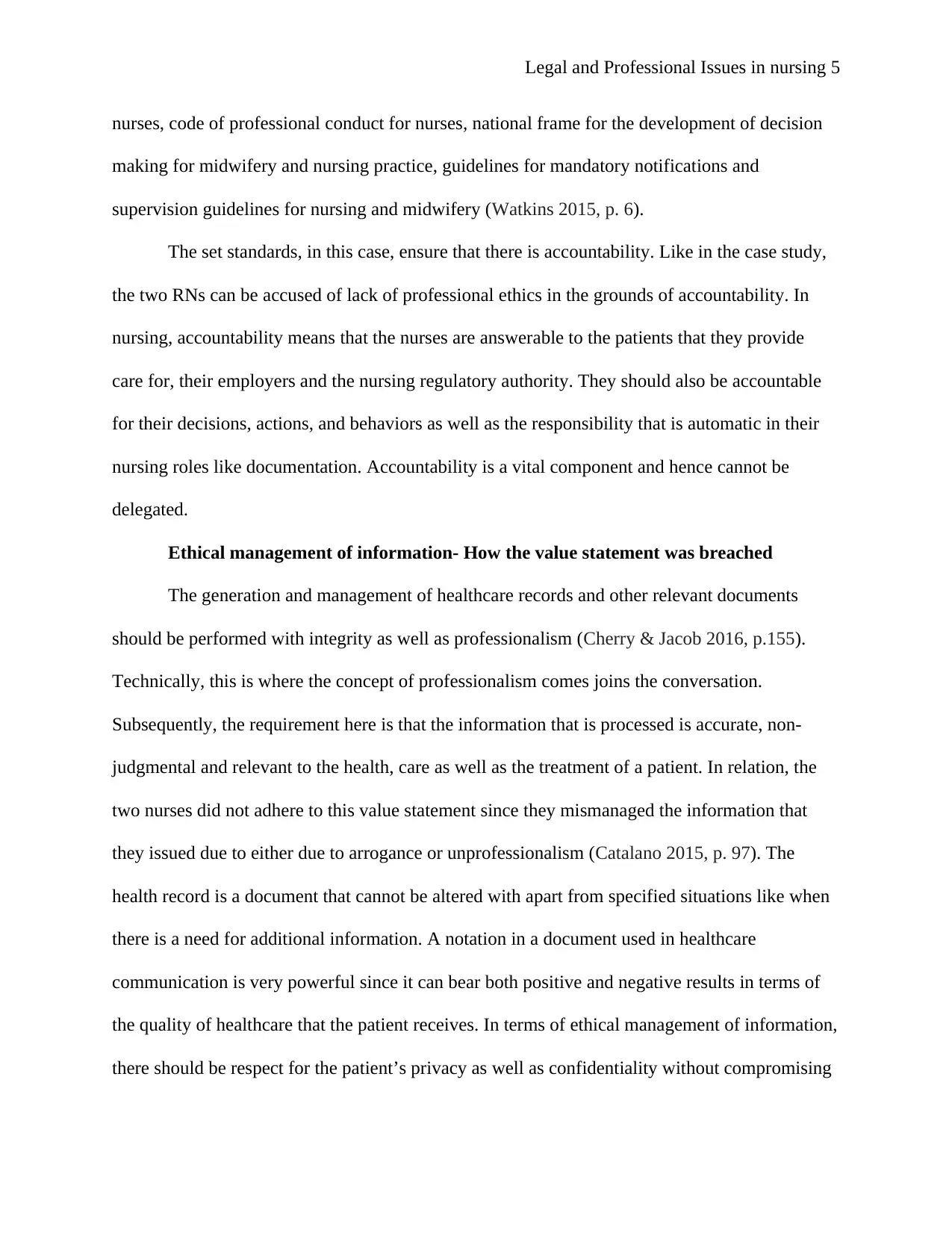
Legal and Professional Issues in nursing 5
nurses, code of professional conduct for nurses, national frame for the development of decision
making for midwifery and nursing practice, guidelines for mandatory notifications and
supervision guidelines for nursing and midwifery (Watkins 2015, p. 6).
The set standards, in this case, ensure that there is accountability. Like in the case study,
the two RNs can be accused of lack of professional ethics in the grounds of accountability. In
nursing, accountability means that the nurses are answerable to the patients that they provide
care for, their employers and the nursing regulatory authority. They should also be accountable
for their decisions, actions, and behaviors as well as the responsibility that is automatic in their
nursing roles like documentation. Accountability is a vital component and hence cannot be
delegated.
Ethical management of information- How the value statement was breached
The generation and management of healthcare records and other relevant documents
should be performed with integrity as well as professionalism (Cherry & Jacob 2016, p.155).
Technically, this is where the concept of professionalism comes joins the conversation.
Subsequently, the requirement here is that the information that is processed is accurate, non-
judgmental and relevant to the health, care as well as the treatment of a patient. In relation, the
two nurses did not adhere to this value statement since they mismanaged the information that
they issued due to either due to arrogance or unprofessionalism (Catalano 2015, p. 97). The
health record is a document that cannot be altered with apart from specified situations like when
there is a need for additional information. A notation in a document used in healthcare
communication is very powerful since it can bear both positive and negative results in terms of
the quality of healthcare that the patient receives. In terms of ethical management of information,
there should be respect for the patient’s privacy as well as confidentiality without compromising
nurses, code of professional conduct for nurses, national frame for the development of decision
making for midwifery and nursing practice, guidelines for mandatory notifications and
supervision guidelines for nursing and midwifery (Watkins 2015, p. 6).
The set standards, in this case, ensure that there is accountability. Like in the case study,
the two RNs can be accused of lack of professional ethics in the grounds of accountability. In
nursing, accountability means that the nurses are answerable to the patients that they provide
care for, their employers and the nursing regulatory authority. They should also be accountable
for their decisions, actions, and behaviors as well as the responsibility that is automatic in their
nursing roles like documentation. Accountability is a vital component and hence cannot be
delegated.
Ethical management of information- How the value statement was breached
The generation and management of healthcare records and other relevant documents
should be performed with integrity as well as professionalism (Cherry & Jacob 2016, p.155).
Technically, this is where the concept of professionalism comes joins the conversation.
Subsequently, the requirement here is that the information that is processed is accurate, non-
judgmental and relevant to the health, care as well as the treatment of a patient. In relation, the
two nurses did not adhere to this value statement since they mismanaged the information that
they issued due to either due to arrogance or unprofessionalism (Catalano 2015, p. 97). The
health record is a document that cannot be altered with apart from specified situations like when
there is a need for additional information. A notation in a document used in healthcare
communication is very powerful since it can bear both positive and negative results in terms of
the quality of healthcare that the patient receives. In terms of ethical management of information,
there should be respect for the patient’s privacy as well as confidentiality without compromising
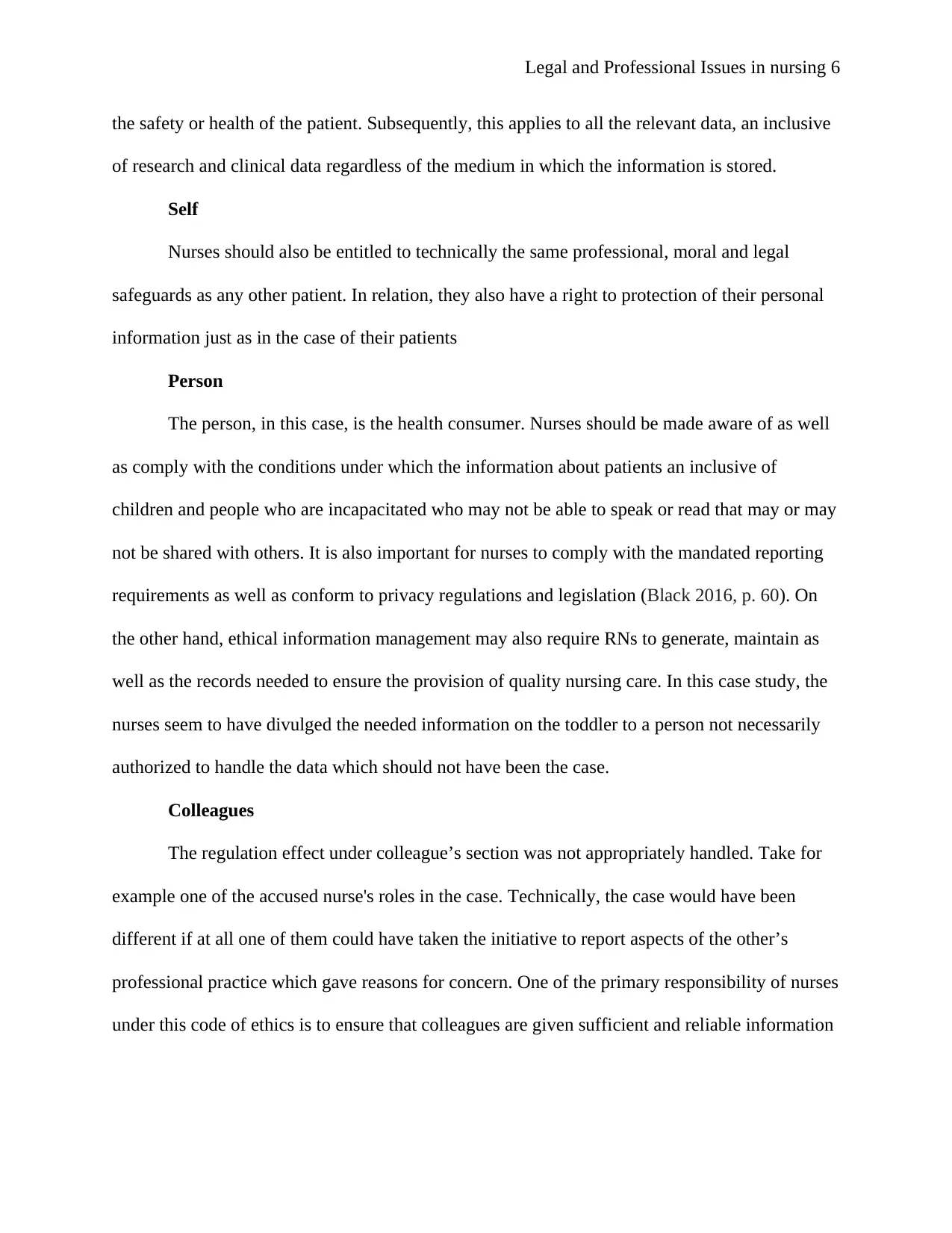
Legal and Professional Issues in nursing 6
the safety or health of the patient. Subsequently, this applies to all the relevant data, an inclusive
of research and clinical data regardless of the medium in which the information is stored.
Self
Nurses should also be entitled to technically the same professional, moral and legal
safeguards as any other patient. In relation, they also have a right to protection of their personal
information just as in the case of their patients
Person
The person, in this case, is the health consumer. Nurses should be made aware of as well
as comply with the conditions under which the information about patients an inclusive of
children and people who are incapacitated who may not be able to speak or read that may or may
not be shared with others. It is also important for nurses to comply with the mandated reporting
requirements as well as conform to privacy regulations and legislation (Black 2016, p. 60). On
the other hand, ethical information management may also require RNs to generate, maintain as
well as the records needed to ensure the provision of quality nursing care. In this case study, the
nurses seem to have divulged the needed information on the toddler to a person not necessarily
authorized to handle the data which should not have been the case.
Colleagues
The regulation effect under colleague’s section was not appropriately handled. Take for
example one of the accused nurse's roles in the case. Technically, the case would have been
different if at all one of them could have taken the initiative to report aspects of the other’s
professional practice which gave reasons for concern. One of the primary responsibility of nurses
under this code of ethics is to ensure that colleagues are given sufficient and reliable information
the safety or health of the patient. Subsequently, this applies to all the relevant data, an inclusive
of research and clinical data regardless of the medium in which the information is stored.
Self
Nurses should also be entitled to technically the same professional, moral and legal
safeguards as any other patient. In relation, they also have a right to protection of their personal
information just as in the case of their patients
Person
The person, in this case, is the health consumer. Nurses should be made aware of as well
as comply with the conditions under which the information about patients an inclusive of
children and people who are incapacitated who may not be able to speak or read that may or may
not be shared with others. It is also important for nurses to comply with the mandated reporting
requirements as well as conform to privacy regulations and legislation (Black 2016, p. 60). On
the other hand, ethical information management may also require RNs to generate, maintain as
well as the records needed to ensure the provision of quality nursing care. In this case study, the
nurses seem to have divulged the needed information on the toddler to a person not necessarily
authorized to handle the data which should not have been the case.
Colleagues
The regulation effect under colleague’s section was not appropriately handled. Take for
example one of the accused nurse's roles in the case. Technically, the case would have been
different if at all one of them could have taken the initiative to report aspects of the other’s
professional practice which gave reasons for concern. One of the primary responsibility of nurses
under this code of ethics is to ensure that colleagues are given sufficient and reliable information
⊘ This is a preview!⊘
Do you want full access?
Subscribe today to unlock all pages.

Trusted by 1+ million students worldwide
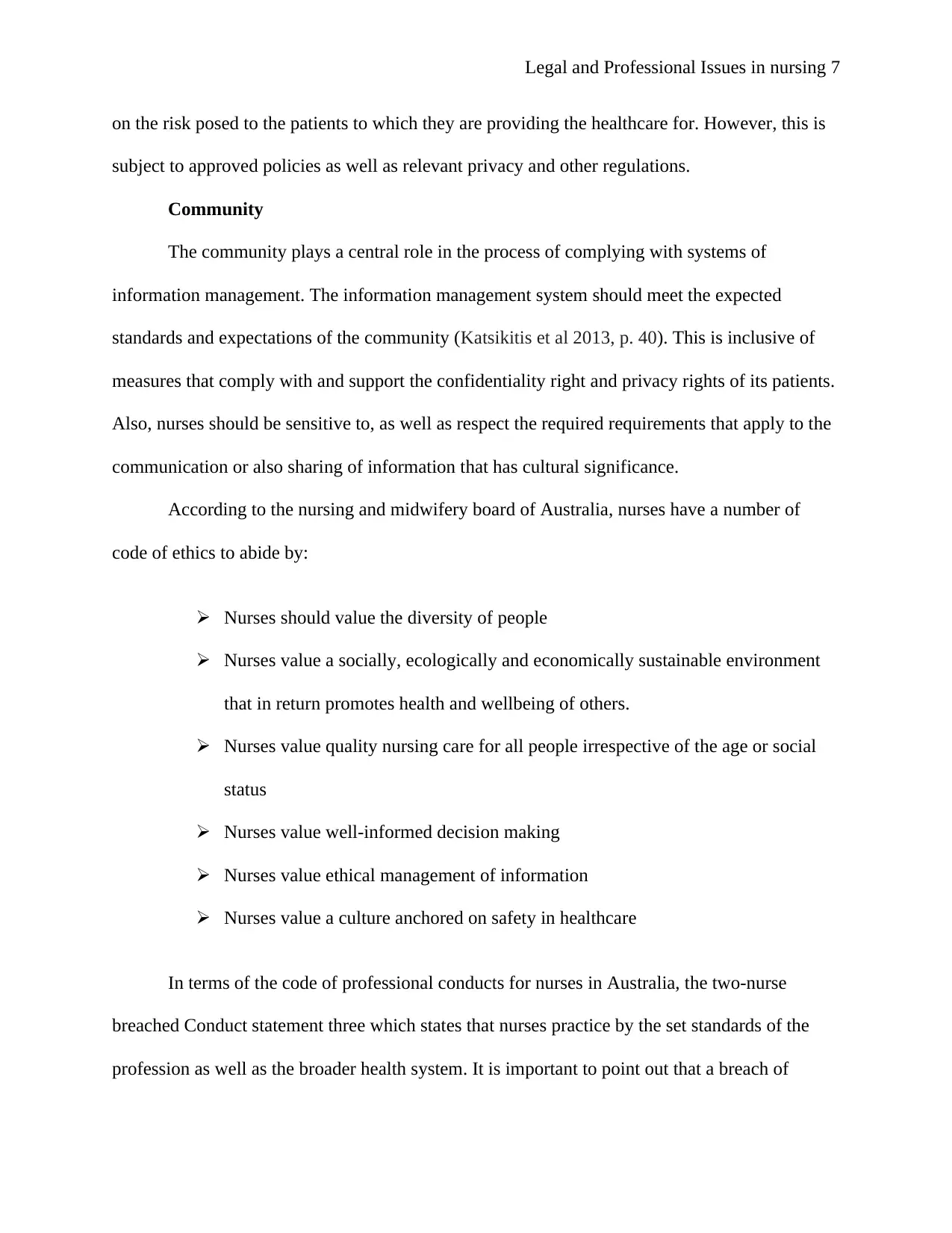
Legal and Professional Issues in nursing 7
on the risk posed to the patients to which they are providing the healthcare for. However, this is
subject to approved policies as well as relevant privacy and other regulations.
Community
The community plays a central role in the process of complying with systems of
information management. The information management system should meet the expected
standards and expectations of the community (Katsikitis et al 2013, p. 40). This is inclusive of
measures that comply with and support the confidentiality right and privacy rights of its patients.
Also, nurses should be sensitive to, as well as respect the required requirements that apply to the
communication or also sharing of information that has cultural significance.
According to the nursing and midwifery board of Australia, nurses have a number of
code of ethics to abide by:
Nurses should value the diversity of people
Nurses value a socially, ecologically and economically sustainable environment
that in return promotes health and wellbeing of others.
Nurses value quality nursing care for all people irrespective of the age or social
status
Nurses value well-informed decision making
Nurses value ethical management of information
Nurses value a culture anchored on safety in healthcare
In terms of the code of professional conducts for nurses in Australia, the two-nurse
breached Conduct statement three which states that nurses practice by the set standards of the
profession as well as the broader health system. It is important to point out that a breach of
on the risk posed to the patients to which they are providing the healthcare for. However, this is
subject to approved policies as well as relevant privacy and other regulations.
Community
The community plays a central role in the process of complying with systems of
information management. The information management system should meet the expected
standards and expectations of the community (Katsikitis et al 2013, p. 40). This is inclusive of
measures that comply with and support the confidentiality right and privacy rights of its patients.
Also, nurses should be sensitive to, as well as respect the required requirements that apply to the
communication or also sharing of information that has cultural significance.
According to the nursing and midwifery board of Australia, nurses have a number of
code of ethics to abide by:
Nurses should value the diversity of people
Nurses value a socially, ecologically and economically sustainable environment
that in return promotes health and wellbeing of others.
Nurses value quality nursing care for all people irrespective of the age or social
status
Nurses value well-informed decision making
Nurses value ethical management of information
Nurses value a culture anchored on safety in healthcare
In terms of the code of professional conducts for nurses in Australia, the two-nurse
breached Conduct statement three which states that nurses practice by the set standards of the
profession as well as the broader health system. It is important to point out that a breach of
Paraphrase This Document
Need a fresh take? Get an instant paraphrase of this document with our AI Paraphraser
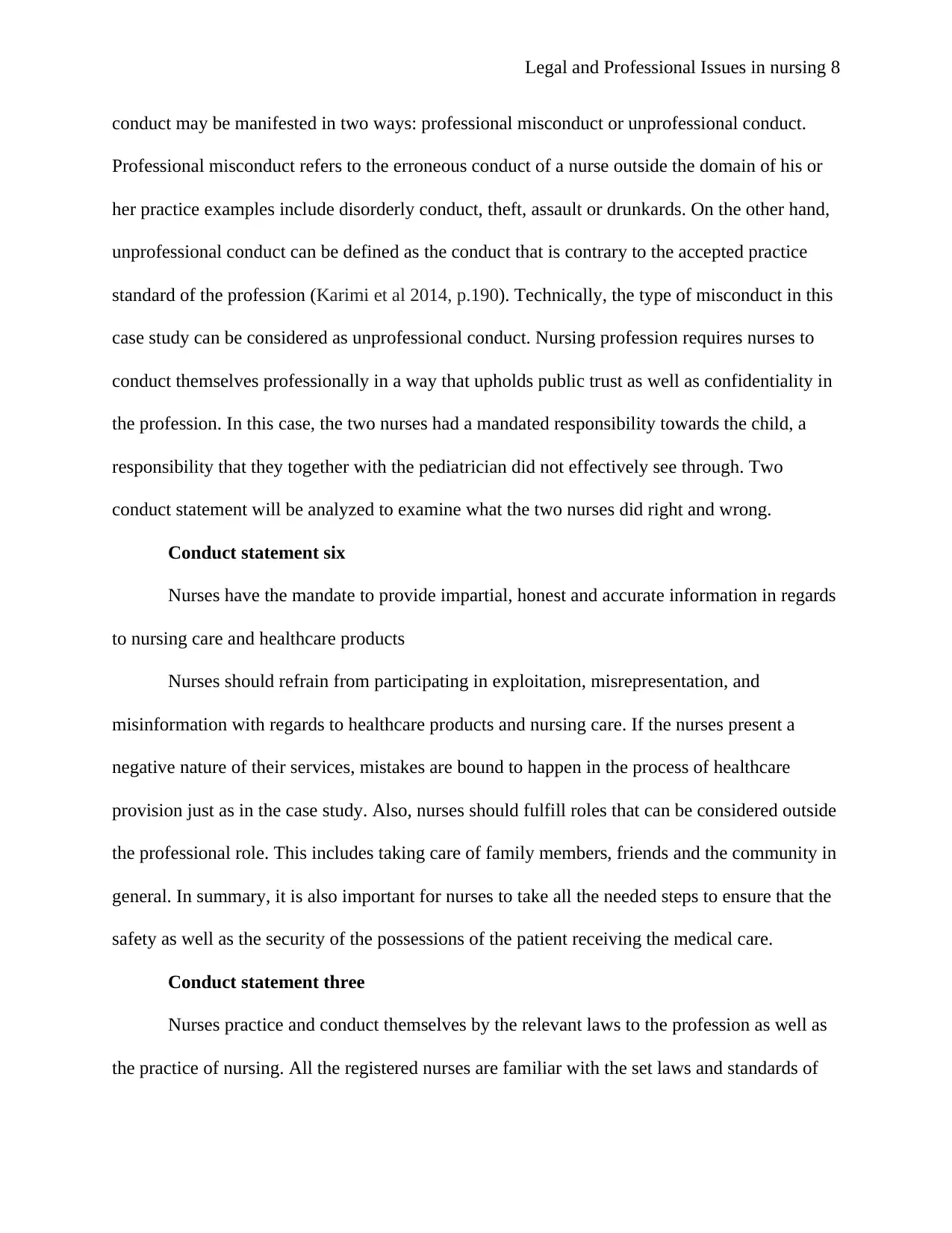
Legal and Professional Issues in nursing 8
conduct may be manifested in two ways: professional misconduct or unprofessional conduct.
Professional misconduct refers to the erroneous conduct of a nurse outside the domain of his or
her practice examples include disorderly conduct, theft, assault or drunkards. On the other hand,
unprofessional conduct can be defined as the conduct that is contrary to the accepted practice
standard of the profession (Karimi et al 2014, p.190). Technically, the type of misconduct in this
case study can be considered as unprofessional conduct. Nursing profession requires nurses to
conduct themselves professionally in a way that upholds public trust as well as confidentiality in
the profession. In this case, the two nurses had a mandated responsibility towards the child, a
responsibility that they together with the pediatrician did not effectively see through. Two
conduct statement will be analyzed to examine what the two nurses did right and wrong.
Conduct statement six
Nurses have the mandate to provide impartial, honest and accurate information in regards
to nursing care and healthcare products
Nurses should refrain from participating in exploitation, misrepresentation, and
misinformation with regards to healthcare products and nursing care. If the nurses present a
negative nature of their services, mistakes are bound to happen in the process of healthcare
provision just as in the case study. Also, nurses should fulfill roles that can be considered outside
the professional role. This includes taking care of family members, friends and the community in
general. In summary, it is also important for nurses to take all the needed steps to ensure that the
safety as well as the security of the possessions of the patient receiving the medical care.
Conduct statement three
Nurses practice and conduct themselves by the relevant laws to the profession as well as
the practice of nursing. All the registered nurses are familiar with the set laws and standards of
conduct may be manifested in two ways: professional misconduct or unprofessional conduct.
Professional misconduct refers to the erroneous conduct of a nurse outside the domain of his or
her practice examples include disorderly conduct, theft, assault or drunkards. On the other hand,
unprofessional conduct can be defined as the conduct that is contrary to the accepted practice
standard of the profession (Karimi et al 2014, p.190). Technically, the type of misconduct in this
case study can be considered as unprofessional conduct. Nursing profession requires nurses to
conduct themselves professionally in a way that upholds public trust as well as confidentiality in
the profession. In this case, the two nurses had a mandated responsibility towards the child, a
responsibility that they together with the pediatrician did not effectively see through. Two
conduct statement will be analyzed to examine what the two nurses did right and wrong.
Conduct statement six
Nurses have the mandate to provide impartial, honest and accurate information in regards
to nursing care and healthcare products
Nurses should refrain from participating in exploitation, misrepresentation, and
misinformation with regards to healthcare products and nursing care. If the nurses present a
negative nature of their services, mistakes are bound to happen in the process of healthcare
provision just as in the case study. Also, nurses should fulfill roles that can be considered outside
the professional role. This includes taking care of family members, friends and the community in
general. In summary, it is also important for nurses to take all the needed steps to ensure that the
safety as well as the security of the possessions of the patient receiving the medical care.
Conduct statement three
Nurses practice and conduct themselves by the relevant laws to the profession as well as
the practice of nursing. All the registered nurses are familiar with the set laws and standards of
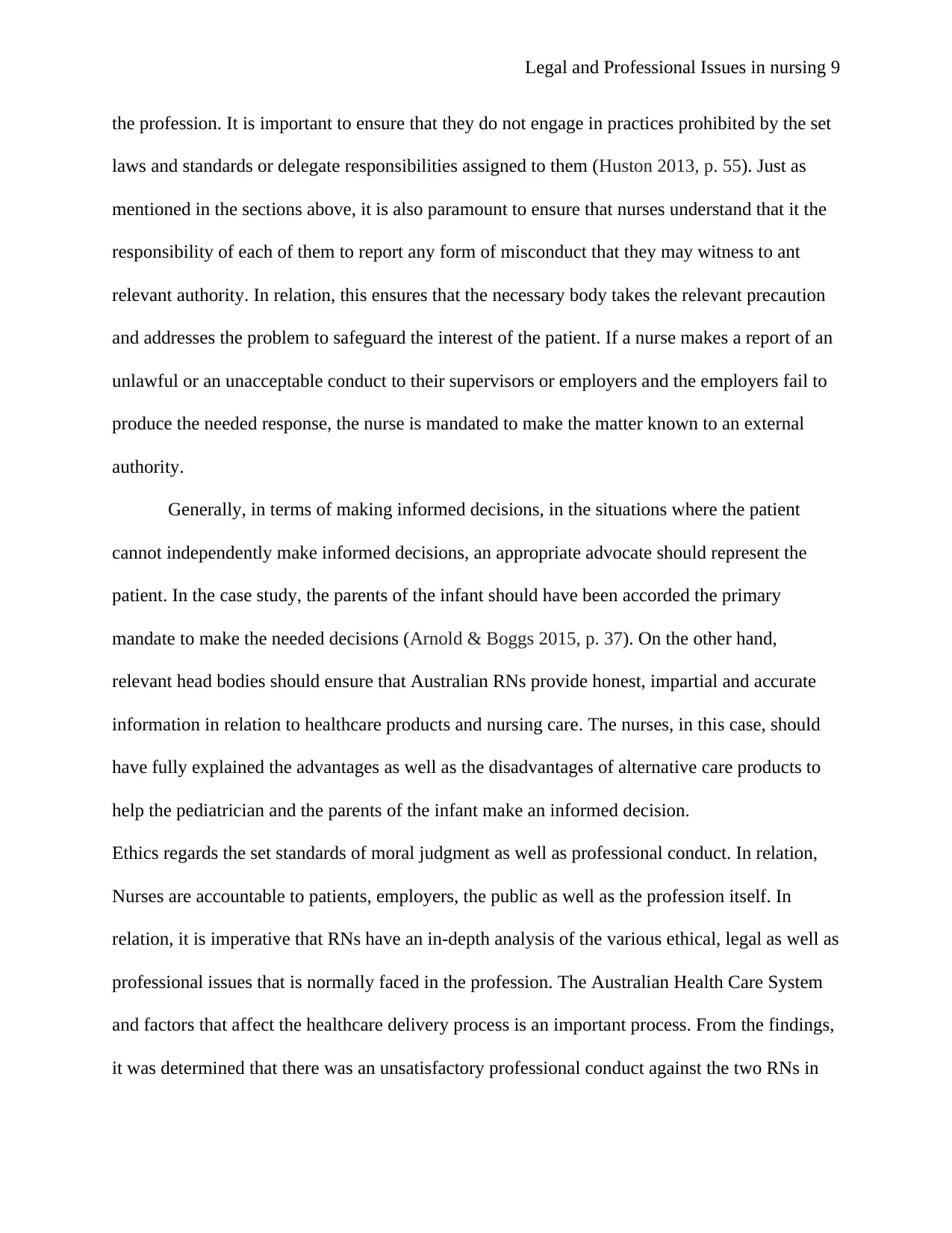
Legal and Professional Issues in nursing 9
the profession. It is important to ensure that they do not engage in practices prohibited by the set
laws and standards or delegate responsibilities assigned to them (Huston 2013, p. 55). Just as
mentioned in the sections above, it is also paramount to ensure that nurses understand that it the
responsibility of each of them to report any form of misconduct that they may witness to ant
relevant authority. In relation, this ensures that the necessary body takes the relevant precaution
and addresses the problem to safeguard the interest of the patient. If a nurse makes a report of an
unlawful or an unacceptable conduct to their supervisors or employers and the employers fail to
produce the needed response, the nurse is mandated to make the matter known to an external
authority.
Generally, in terms of making informed decisions, in the situations where the patient
cannot independently make informed decisions, an appropriate advocate should represent the
patient. In the case study, the parents of the infant should have been accorded the primary
mandate to make the needed decisions (Arnold & Boggs 2015, p. 37). On the other hand,
relevant head bodies should ensure that Australian RNs provide honest, impartial and accurate
information in relation to healthcare products and nursing care. The nurses, in this case, should
have fully explained the advantages as well as the disadvantages of alternative care products to
help the pediatrician and the parents of the infant make an informed decision.
Ethics regards the set standards of moral judgment as well as professional conduct. In relation,
Nurses are accountable to patients, employers, the public as well as the profession itself. In
relation, it is imperative that RNs have an in-depth analysis of the various ethical, legal as well as
professional issues that is normally faced in the profession. The Australian Health Care System
and factors that affect the healthcare delivery process is an important process. From the findings,
it was determined that there was an unsatisfactory professional conduct against the two RNs in
the profession. It is important to ensure that they do not engage in practices prohibited by the set
laws and standards or delegate responsibilities assigned to them (Huston 2013, p. 55). Just as
mentioned in the sections above, it is also paramount to ensure that nurses understand that it the
responsibility of each of them to report any form of misconduct that they may witness to ant
relevant authority. In relation, this ensures that the necessary body takes the relevant precaution
and addresses the problem to safeguard the interest of the patient. If a nurse makes a report of an
unlawful or an unacceptable conduct to their supervisors or employers and the employers fail to
produce the needed response, the nurse is mandated to make the matter known to an external
authority.
Generally, in terms of making informed decisions, in the situations where the patient
cannot independently make informed decisions, an appropriate advocate should represent the
patient. In the case study, the parents of the infant should have been accorded the primary
mandate to make the needed decisions (Arnold & Boggs 2015, p. 37). On the other hand,
relevant head bodies should ensure that Australian RNs provide honest, impartial and accurate
information in relation to healthcare products and nursing care. The nurses, in this case, should
have fully explained the advantages as well as the disadvantages of alternative care products to
help the pediatrician and the parents of the infant make an informed decision.
Ethics regards the set standards of moral judgment as well as professional conduct. In relation,
Nurses are accountable to patients, employers, the public as well as the profession itself. In
relation, it is imperative that RNs have an in-depth analysis of the various ethical, legal as well as
professional issues that is normally faced in the profession. The Australian Health Care System
and factors that affect the healthcare delivery process is an important process. From the findings,
it was determined that there was an unsatisfactory professional conduct against the two RNs in
⊘ This is a preview!⊘
Do you want full access?
Subscribe today to unlock all pages.

Trusted by 1+ million students worldwide
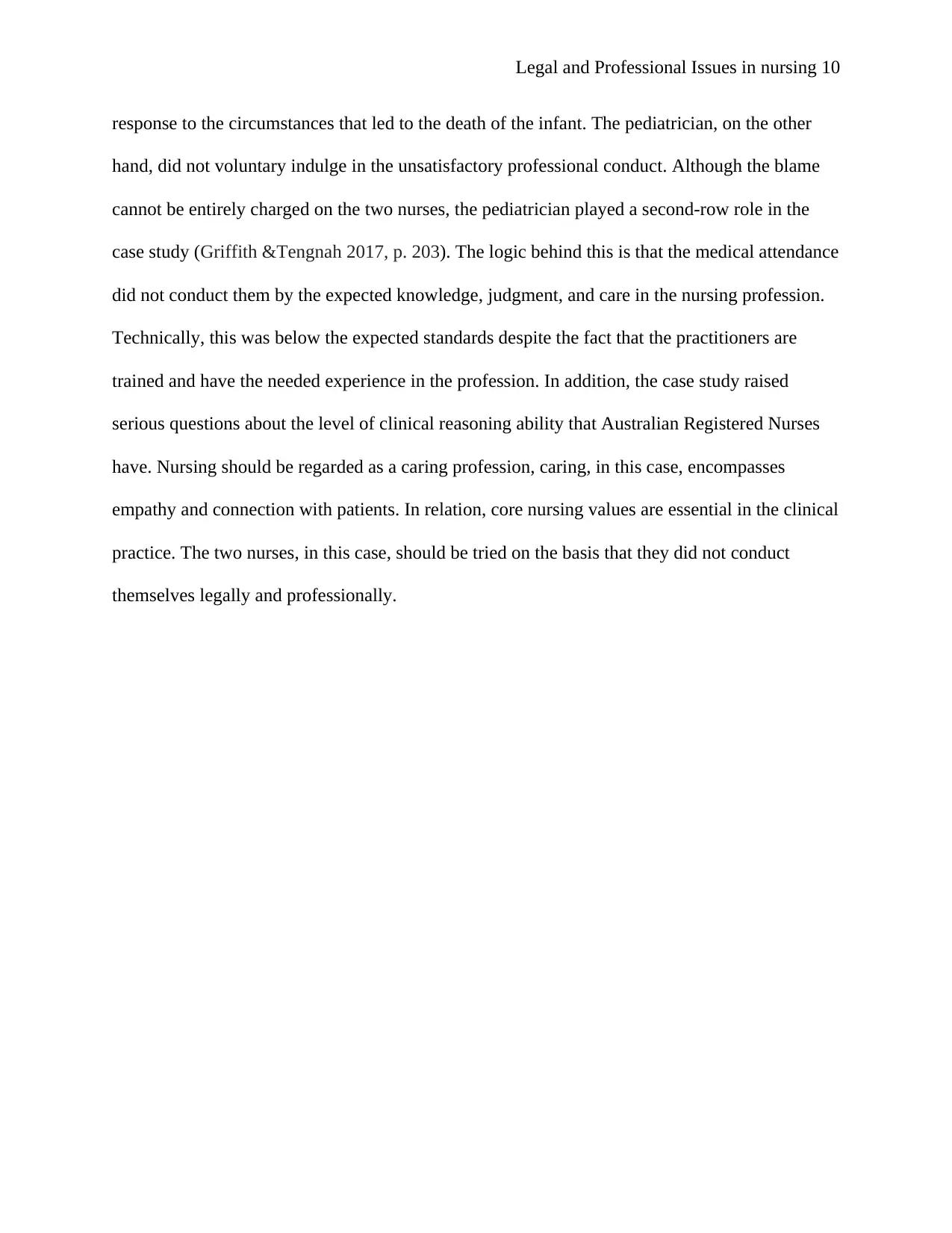
Legal and Professional Issues in nursing 10
response to the circumstances that led to the death of the infant. The pediatrician, on the other
hand, did not voluntary indulge in the unsatisfactory professional conduct. Although the blame
cannot be entirely charged on the two nurses, the pediatrician played a second-row role in the
case study (Griffith &Tengnah 2017, p. 203). The logic behind this is that the medical attendance
did not conduct them by the expected knowledge, judgment, and care in the nursing profession.
Technically, this was below the expected standards despite the fact that the practitioners are
trained and have the needed experience in the profession. In addition, the case study raised
serious questions about the level of clinical reasoning ability that Australian Registered Nurses
have. Nursing should be regarded as a caring profession, caring, in this case, encompasses
empathy and connection with patients. In relation, core nursing values are essential in the clinical
practice. The two nurses, in this case, should be tried on the basis that they did not conduct
themselves legally and professionally.
response to the circumstances that led to the death of the infant. The pediatrician, on the other
hand, did not voluntary indulge in the unsatisfactory professional conduct. Although the blame
cannot be entirely charged on the two nurses, the pediatrician played a second-row role in the
case study (Griffith &Tengnah 2017, p. 203). The logic behind this is that the medical attendance
did not conduct them by the expected knowledge, judgment, and care in the nursing profession.
Technically, this was below the expected standards despite the fact that the practitioners are
trained and have the needed experience in the profession. In addition, the case study raised
serious questions about the level of clinical reasoning ability that Australian Registered Nurses
have. Nursing should be regarded as a caring profession, caring, in this case, encompasses
empathy and connection with patients. In relation, core nursing values are essential in the clinical
practice. The two nurses, in this case, should be tried on the basis that they did not conduct
themselves legally and professionally.
Paraphrase This Document
Need a fresh take? Get an instant paraphrase of this document with our AI Paraphraser
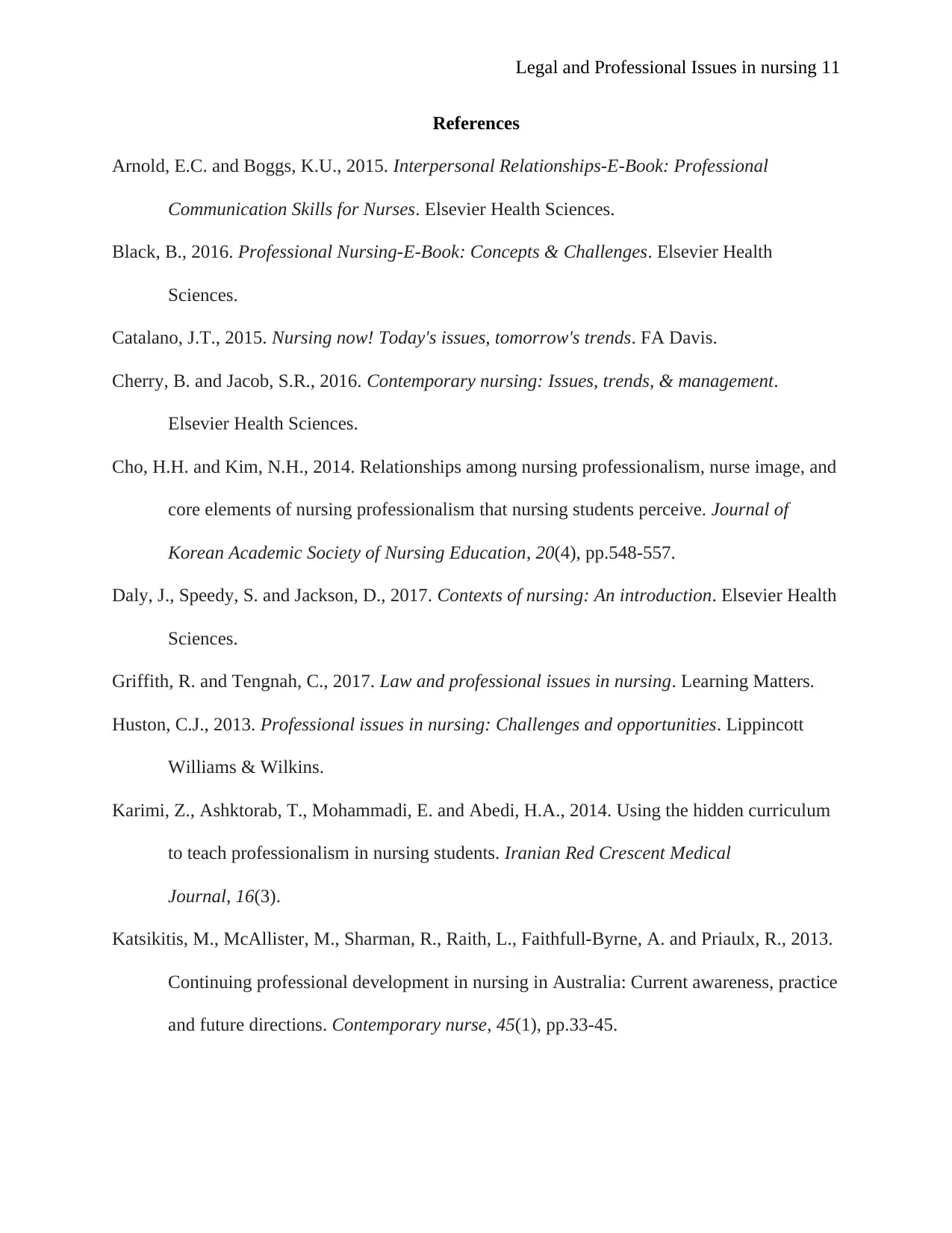
Legal and Professional Issues in nursing 11
References
Arnold, E.C. and Boggs, K.U., 2015. Interpersonal Relationships-E-Book: Professional
Communication Skills for Nurses. Elsevier Health Sciences.
Black, B., 2016. Professional Nursing-E-Book: Concepts & Challenges. Elsevier Health
Sciences.
Catalano, J.T., 2015. Nursing now! Today's issues, tomorrow's trends. FA Davis.
Cherry, B. and Jacob, S.R., 2016. Contemporary nursing: Issues, trends, & management.
Elsevier Health Sciences.
Cho, H.H. and Kim, N.H., 2014. Relationships among nursing professionalism, nurse image, and
core elements of nursing professionalism that nursing students perceive. Journal of
Korean Academic Society of Nursing Education, 20(4), pp.548-557.
Daly, J., Speedy, S. and Jackson, D., 2017. Contexts of nursing: An introduction. Elsevier Health
Sciences.
Griffith, R. and Tengnah, C., 2017. Law and professional issues in nursing. Learning Matters.
Huston, C.J., 2013. Professional issues in nursing: Challenges and opportunities. Lippincott
Williams & Wilkins.
Karimi, Z., Ashktorab, T., Mohammadi, E. and Abedi, H.A., 2014. Using the hidden curriculum
to teach professionalism in nursing students. Iranian Red Crescent Medical
Journal, 16(3).
Katsikitis, M., McAllister, M., Sharman, R., Raith, L., Faithfull-Byrne, A. and Priaulx, R., 2013.
Continuing professional development in nursing in Australia: Current awareness, practice
and future directions. Contemporary nurse, 45(1), pp.33-45.
References
Arnold, E.C. and Boggs, K.U., 2015. Interpersonal Relationships-E-Book: Professional
Communication Skills for Nurses. Elsevier Health Sciences.
Black, B., 2016. Professional Nursing-E-Book: Concepts & Challenges. Elsevier Health
Sciences.
Catalano, J.T., 2015. Nursing now! Today's issues, tomorrow's trends. FA Davis.
Cherry, B. and Jacob, S.R., 2016. Contemporary nursing: Issues, trends, & management.
Elsevier Health Sciences.
Cho, H.H. and Kim, N.H., 2014. Relationships among nursing professionalism, nurse image, and
core elements of nursing professionalism that nursing students perceive. Journal of
Korean Academic Society of Nursing Education, 20(4), pp.548-557.
Daly, J., Speedy, S. and Jackson, D., 2017. Contexts of nursing: An introduction. Elsevier Health
Sciences.
Griffith, R. and Tengnah, C., 2017. Law and professional issues in nursing. Learning Matters.
Huston, C.J., 2013. Professional issues in nursing: Challenges and opportunities. Lippincott
Williams & Wilkins.
Karimi, Z., Ashktorab, T., Mohammadi, E. and Abedi, H.A., 2014. Using the hidden curriculum
to teach professionalism in nursing students. Iranian Red Crescent Medical
Journal, 16(3).
Katsikitis, M., McAllister, M., Sharman, R., Raith, L., Faithfull-Byrne, A. and Priaulx, R., 2013.
Continuing professional development in nursing in Australia: Current awareness, practice
and future directions. Contemporary nurse, 45(1), pp.33-45.
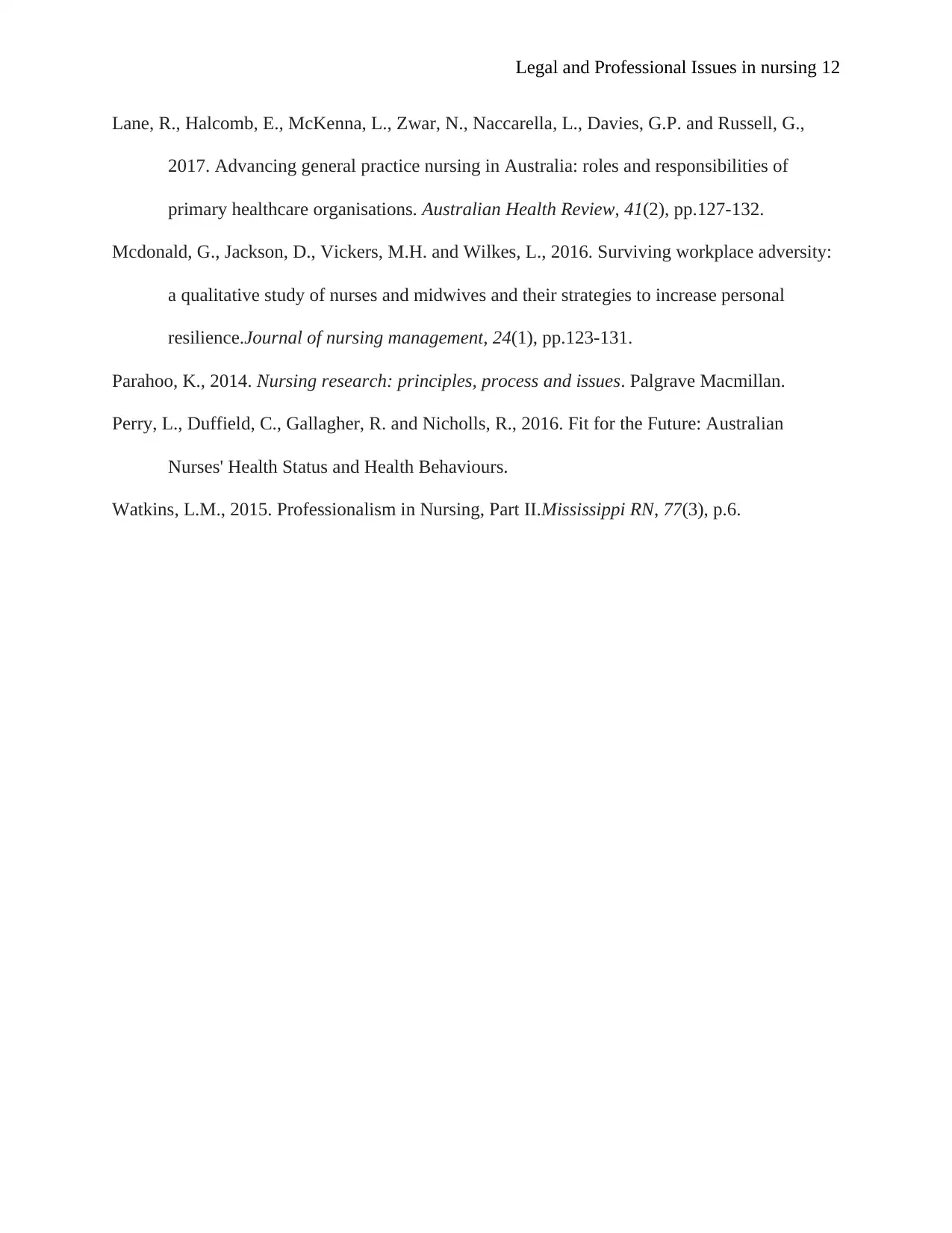
Legal and Professional Issues in nursing 12
Lane, R., Halcomb, E., McKenna, L., Zwar, N., Naccarella, L., Davies, G.P. and Russell, G.,
2017. Advancing general practice nursing in Australia: roles and responsibilities of
primary healthcare organisations. Australian Health Review, 41(2), pp.127-132.
Mcdonald, G., Jackson, D., Vickers, M.H. and Wilkes, L., 2016. Surviving workplace adversity:
a qualitative study of nurses and midwives and their strategies to increase personal
resilience.Journal of nursing management, 24(1), pp.123-131.
Parahoo, K., 2014. Nursing research: principles, process and issues. Palgrave Macmillan.
Perry, L., Duffield, C., Gallagher, R. and Nicholls, R., 2016. Fit for the Future: Australian
Nurses' Health Status and Health Behaviours.
Watkins, L.M., 2015. Professionalism in Nursing, Part II.Mississippi RN, 77(3), p.6.
Lane, R., Halcomb, E., McKenna, L., Zwar, N., Naccarella, L., Davies, G.P. and Russell, G.,
2017. Advancing general practice nursing in Australia: roles and responsibilities of
primary healthcare organisations. Australian Health Review, 41(2), pp.127-132.
Mcdonald, G., Jackson, D., Vickers, M.H. and Wilkes, L., 2016. Surviving workplace adversity:
a qualitative study of nurses and midwives and their strategies to increase personal
resilience.Journal of nursing management, 24(1), pp.123-131.
Parahoo, K., 2014. Nursing research: principles, process and issues. Palgrave Macmillan.
Perry, L., Duffield, C., Gallagher, R. and Nicholls, R., 2016. Fit for the Future: Australian
Nurses' Health Status and Health Behaviours.
Watkins, L.M., 2015. Professionalism in Nursing, Part II.Mississippi RN, 77(3), p.6.
⊘ This is a preview!⊘
Do you want full access?
Subscribe today to unlock all pages.

Trusted by 1+ million students worldwide
1 out of 12
Related Documents
Your All-in-One AI-Powered Toolkit for Academic Success.
+13062052269
info@desklib.com
Available 24*7 on WhatsApp / Email
![[object Object]](/_next/static/media/star-bottom.7253800d.svg)
Unlock your academic potential
Copyright © 2020–2025 A2Z Services. All Rights Reserved. Developed and managed by ZUCOL.





